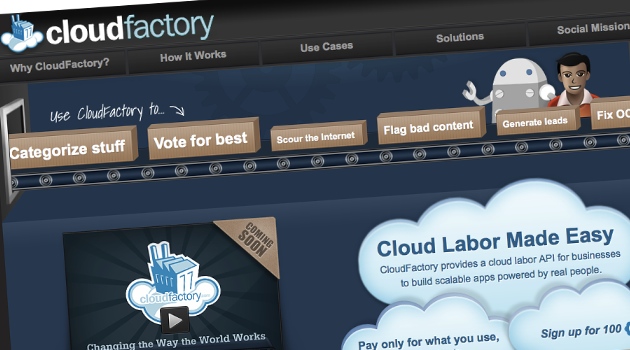NEPAL > CloudFactory, From the Heights of Nepal, Can Put 1 Million Cloud Workers Into Business
This original article can be found at www.techinasia.com/cloudfactory-nepal/in TechInAsia website.

CloudFactory is a fascinating business and concept, not just because it’s based in the Himalayan nation of Nepal, but because it can put one million people in developing countries – including in Nepal itself – into work on the web.
Those folks get employment doing basic computer work from their own home, while the companies that make use of the CloudFactory service get that huge human workforce to do tasks online like flagging bad content, inputting data, transcribing audio, fixing OCR, tagging images, etc. Essentially, many kinds of digitization, categorization, moderation, or even translation.
Started up in 2008 by Mark Sears, who came to Nepal with his wife on a two week vacation that never quite ended, the business itself employs 40 staff, mostly software engineers, in its Kathmandu office. Its cloud workers are scattered across the globe – mostly in poorer nations where work can be hard to come by – and are more than just a database of names. Using the microloan model, CloudFactory aims to put its cloud labor force into work as independent businesspeople, helping them purchase the kind of low-end tablet or netbook that can get them started.
To learn more about the region and the business model, TiA chatted with Tom Puskarich, the VP of business development, and got some founder’s insights from Mark Sears (both pictured below) as well. First up, Tom fields the questions:
1. Startups often have a tough time finding talent for their own team. How is that situation in Kathmandu, or Nepal in general?

Tom: Kathmandu’s universities put out hundreds of computer engineers every year; and with the lack of work opportunities, these engineers are hungry and motivated, especially for a Silicon Valley-style startup right in their backyard. Add that to the social mission of being a part of not only trying to change their own country but using their skills to change how the world works and create millions of jobs for those in developing countries, and you’ve got a recipe some seriously motivated talent. We’re certainly not at a loss to find programmers with a passion for developing software for the developing world, in the developing world.
2. Your CloudFactory creates opportunities for a claimed million “cloud workers” to do things like digitization, moderation, translation, etc. How does the system work, and what’s the deal for all these workers?
Tom: We use several worker pools, some of which are in Nepal and others through partnerships such as Amazon’s Mechanical Turk. The idea behind all of these systems is a massively distributed workforce who get the huge benefit of not only working from wherever they would like, but also whenever they would like. Our own workforce, that is starting in Nepal, has much more opportunity for growth, training, and feedback which will then give our clients higher quality results.
3. You have a business card scanning app called BizcardArmy which is a sort of showcase for the CloudFactory.
Tom: BizcardArmy is a great example of CloudFactory in a market flooded with automated business card scanning apps that don’t really work. The efficient and on-demand human workforce that CloudFactory provides is the perfect solution for both the business and the users who get a great solution for turning paper business cards into contacts on their phones. As I said, this is just an example of the power of CloudFactory, and these same principles can be applied to all kinds of ideas from savvy entrepreneurs.
4. What’s your personal startup/entrepreneur story?

Mark: My wife and I actually came to Nepal for a two-week vacation – and that kept getting extended. Three and a half years later we are still here and have teamed up with Tom and his wife to take CloudFactory to the next level. Initially we started as a Ruby on Rails outsourcing company and grew quickly as we hired smart young computer engineers and trained them up.
Then we wanted to give training and opportunities to other talented people in Nepal and other developing countries. At the same time we were getting requests from clients to hire people in Nepal to do lead generation, image and video tagging, and other non-programming work. The supply and demand were there, so we started work on an innovative platform to bridge the gap. Initially it was a side project where we reinvested profits and extra time from the outsourcing side of the business, but since January it is now 100 percent of our focus.
5. How’s the startup scene in Nepal?
Tom: To describe Nepal in a word would be “adventure” – which is also how you could describe the startup scene. Wherever it exists in the world. Startups are not for the faint of heart whether you’re an entrepreneur, an investor, or a geek looking to change the world. So, in one way, you could look at Nepal and find all the reasons doing a startup in a country like Nepal is difficult, but if you’re ready to generate your own electricity and pass a few cows on the way to work, you may just find all the hidden advantages that go along with creating a startup at the top of the world; not the least of which is an awesome and hungry workforce or the breath-taking mountain views from the office.




